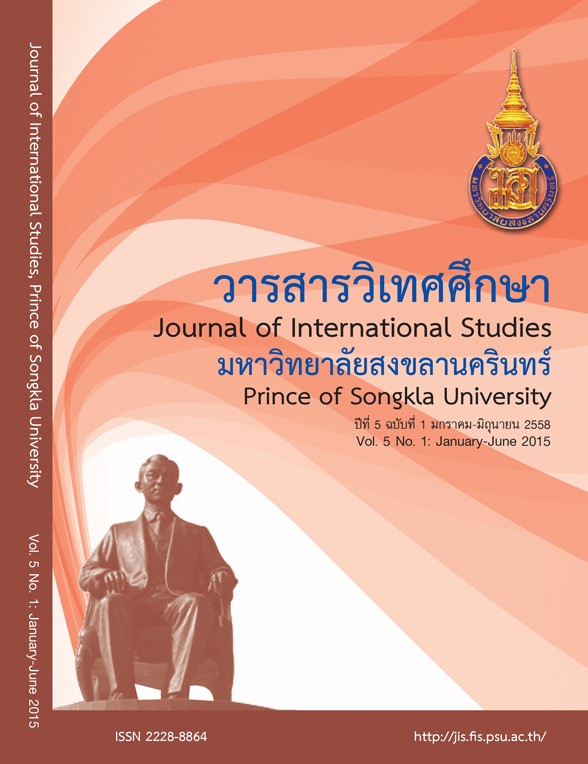Factors Affecting Social Changes of Urak Lawoi Households in Lipe Island, Satun Province
Main Article Content
Abstract
The purposes of this research were to study social charecteristics of Urak Lawoi households, and to analyse fators affecting their social changes. The research instrument was the structured questionnaires. Data were analysed by using percentage and Pearson’s correlation coefficient. 128 questionnaires (92.8 % of Urak Lawoi household) were collected. The study found that statistically significant factors affecting social changes of Urak Lawoi households in a positive way were 1) number of household members, 2) main occupation, 3) household income, 4) adequncy of income 5) deprivation of land rights, and 6) court cases. The statistically significant factors affecting social changes in a negative way were 1) commitment in Tao-kae fishery system, 2) employee engagement in tourism business, 3) household income, 4) supply of fresh water, 5) gabage, and 6) deprivation of land rights.
Article Details
Statements and opinions expressed in articles herein are those of the authors and do not necessarily reflect the position of the editors or publisher.
Article, information, text, image, etc. which are published in Journal of International Studies, belong to Journal of International Studies. If anybody or any organization would like to use part or whole of them, they must receive written permission from Journal of International Studies before usage.
References
มหาวิทยาลัยเกษตรศาสตร์.
เฉลียว ฤกษ์รุจิพิมล และคณะ. (2548). มนุษย์กับสังคม. พิมพ์ครั้งที่ 6.
กรุงเทพฯ: มหาวิทยาลัยเกษตรศาสตร์
ดาฤนัย จรูญทอง. (2550). ประวัติศาสตร์ชุมชนอูรักลาโว้ยเกาะหลีเป๊ะ
จังหวัดสตูล ระหว่างปี พ.ศ. 2493-2549. การค้นคว้าอิสระปริญญาอักษร
ศาสตรมหาบัณฑิต คณะบัณฑิตวิทยาลัย มหาวิทยาลัยศิลปากร, นครปฐม.
หน่วยพิพักษ์อุทยานแห่งชาติตะรุเตา. (2554).รายงานผลการสำรวจจำนวน
ประชากรชาวเลในพื้นที่ เกาะอาดัง. อุทยานแห่งชาติตะรุเตา.
ฝ่ายจัดการทรัพยากร ธรรมชาติในอุทยานแห่งชาติ.
สำนักงานเทศบาลอำเภอเมืองสตูล. (2556). แบบรายงานบัญชีคนในบ้าน
ตำบลเกาะสาหร่าย อำเภอเมือง จังหวัดสตูล. เทศบาลอำเภอเมืองสตูล.
Faulkner, B. and C. Tideswell. 1997. A framework for monitoring
community impacts of tourism. Journal of Sustainable Tourism.
Vol.5, pp. 3-28.
Granbom, A. (2005). Urak Lawoi. Working Paper in Social
Anthropology. Department of Sociology. Lund University:
Sweden.
Hogan, D. (1972). Men of the sea: coastal tribes of south Thailand’s west coast. Journey of the Siam society, Vol.60, pp. 205-235.
Howell, D.C. (2004). Fundamental Statistics for the Behavioral
Sciences, 5th. Duxbury Press. Pacific Grove.
McElroy, J. and Olazarri, P. (1997). A tourism penetration index for
small island destinations. Bank of of Valletta Review. Vol.16,
pp. 1-10.
Monterrubio, J. C., Fernandez, M. J., and Gullete, G. S. (2011).
Tourism and social change. A qualitative study on community
perceptions in Huatulco, Mexico. Cuadernos de Tourismo.
Vol.28, pp. 255-256.
Prapruit, P. and B., Somboonsuke. (2014). Impact of tourism on
livelihood of Urak Lawoi in Lipe island. The PSU-USM-NSTRU
International Conference on Arts and Sciences 2014. “Arts and
Sciences Research 2014: Spot of Change for Tomorrow” ; 2-3
June 2014; Songkhla, Thailand.
Regina, S. and M. Janet, 2008. Tourism in small island states: from
vulnerability to strengths. Journal of Sustainable Tourism.
Vol.16, pp.491-510.
Wongbusarakum, S. (2007). The Urak Lawoi and the Complexity of
Sustainable Resource Use: the Adang Archipelago, Andaman
Sea, Thailand. Ph.D Dissertation. University of Hawai.


